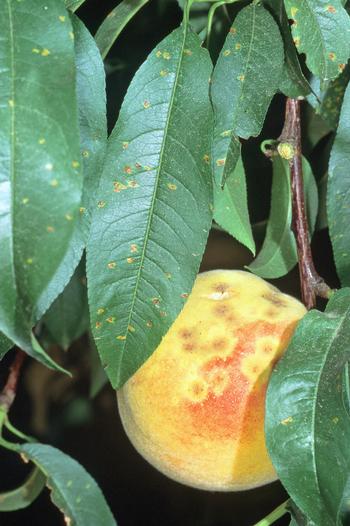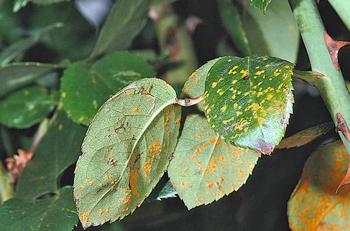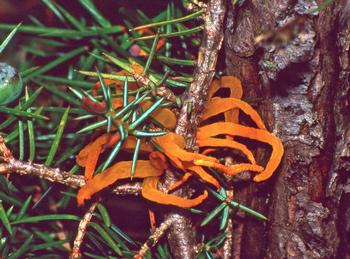The Rusts
-
Nanette Londeree
-
What happens when you combine mild weather, rain that lasts for a day or two, and rapidly growing plants fighting for space? Besides a bounty of flowers, foliage might take on an orange-splattered look. Nature’s overhead irrigation is not only a boon for the garden and the gardener but also creates perfect growing conditions for the disease rust.
 Small, sunken dark rust lesions on peaches will split open by the time the fruit is ripe. Photo: Jack Kelly Clark, UC Regents
Small, sunken dark rust lesions on peaches will split open by the time the fruit is ripe. Photo: Jack Kelly Clark, UC RegentsOne of the most common fungal diseases of garden plants, there are thousands of different species of rust that infect trees, shrubs, ferns, perennials, edibles, and more, like pear, peach, pine, rhododendrons, roses, chrysanthemums, fuchsias, geraniums, lilies, and snapdragons. Rusts have been a scourge to humans for centuries, impacting important food and fiber crops like grains, bean and soybean, asparagus, cotton, apple, and even coffee. Besides being unsightly, they can reduce plant vigor and, in extreme cases, even kill the plant.
Rust fungi and their damage usually occur on the leaves, stems, and fruit of broadleaf plants and the bark or needles of conifers. The distinctive rusty-looking powdery spore masses on the undersides of infected leaves and other plant parts are called pustules. Early in the season, they may appear yellow to light orange and, in summer, deepen in color to dark orange-red brown. They look like orange, gelatinous masses on some evergreen hosts.
Many rusts have minimal effect on plant health, but certain rusts can kill their hosts. Infected foliage on broadleaf plants may become spotted, turn yellow or brown, and drop prematurely. Severe rust on peach trees can cause defoliation and reduce yield. Fruit may display small, sunken dark lesions that split open by the time the fruit is ripe. Other species damage bark, producing tissue swellings or galls, colorful spots, or cankers, branch dieback, and potentially kill the entire plant.
As parasitic biotrophs, these fungi need a living host. They cannot survive on dead plant material unless they produce a special type of spore, a thick-walled resting spore that allows the disease to survive through the winter and persist from one season to the next in plant debris. Rose rust pustules are visible on the lower surface of the leaf while the top surface appears spotted. Photo: WikiMedia Commons
Rose rust pustules are visible on the lower surface of the leaf while the top surface appears spotted. Photo: WikiMedia CommonsMost species of rust fungi have complex life cycles and alternate generations between two hosts in different plant families. The rust disease that affects an ornamental tree may have an alternate host that is just an incidental plant in the landscape or even a crop or a weed. Some species, like rose rust, have only a single host.
Rusts require free water to reproduce, so rainy weather, heavy overnight dew, or overhead watering that wets foliage without enough time to dry produce optimum conditions for this disease, especially with temperatures at 65–70 degrees F. Infection is spread primarily by windblown or water-splashed spores that have survived over the winter.
To prevent rust from getting a foothold in the garden: Rainy weather with mild temperatures are ideal growing conditions for this disease. Photo: PxHere
Rainy weather with mild temperatures are ideal growing conditions for this disease. Photo: PxHereKeep it out:
- Choose disease-resistant varieties – check seed catalogs, seed packages, and plant labels for resistance information.
- Before buying plants, look closely at the inner and lower leaves to confirm they are disease free before bringing them into the garden.
- Where possible, don’t grow alternate host plants.
Provide excellent cultural conditions: Locate plants so they receive plenty of sunlight and air circulation (don’t crowd them). Maintain healthy soil, and avoid excess nitrogen that results in soft, lush growth.
Manage moisture: Avoid overhead watering, or if necessary, do it early in the day to allow time for leaves to dry quickly. Use drip irrigation or a soaker hose to apply water to the soil, not the leaves. Orange, gelatinous masses form on some types of evergreen hosts like this juniper. Photo: WikiMedia Commons
Orange, gelatinous masses form on some types of evergreen hosts like this juniper. Photo: WikiMedia CommonsClean it clean:
- Pinch off rust-infected leaves and remove them from the garden, though don’t remove more than one-third of the plant’s foliage.
- Remove and destroy infected twigs, buds, and fruit as soon as symptoms appear.
- Collect fallen, infected leaves and needles and dispose of them away from host plants.




